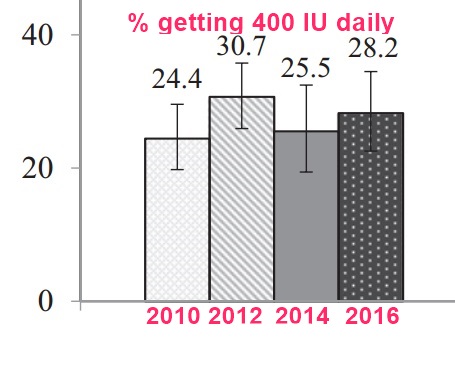73 percent of US infants still do not even get 400 IU of Vitamin D
Adherence to Vitamin D Intake Guidelines in the United States
Alan E. Simon and Katherine A. Ahrens
Pediatrics June 2020, 145 (6) e20193574; DOI: https://doi.org/10.1542/peds.2019-3574

📄 Download the PDF from Vitamin D Life
BACKGROUND: The American Academy of Pediatrics (AAP) revised its infant vitamin D intake guidelines in 2008. We aimed to examine previously unexplored trends in meeting vitamin D intake guidelines among US infants since 2009 and whether there were differences across demographic subgroups.
METHODS: We analyzed dietary recall data for infants 0 to 11 months in the 2009–2016 NHANES. We estimated the percentage meeting 2008 AAP vitamin D guidelines, defined as consuming ≥1 L of infant formula and/or receiving a vitamin D supplement of ≥400 IU. We used Poisson regressions to assess trends over time and differences across demographic subgroups.
RESULTS: Overall, 27.1% (95% confidence interval [CI]: 24.3%–29.8%) of US infants in 2009–2016 met vitamin D intake guidelines, with nonbreastfeeding infants (31.1% [95% CI: 27.6%–34.5%]) more likely to meet guidelines than breastfeeding infants (20.5% [95% CI: 15.4%–25.5%]; P < .01). From 2009–2010 to 2015–2016, overall and for both breastfeeding and nonbreastfeeding infants, there were no significant changes over time in the percentage of infants who met the guidelines (P > .05). Among breastfeeding infants, those with a family income ≥400% of the federal poverty level, with a college graduate head of household, and with private insurance were more likely to meet guidelines.
CONCLUSIONS: Among US infants, we observed no increase in meeting AAP vitamin D intake guidelines since 2009. Less than 40% of infants met guidelines in nearly all demographic subgroups. These findings suggest renewed consideration of how to best meet vitamin D intake guidelines.
